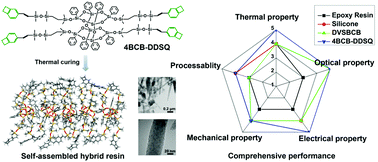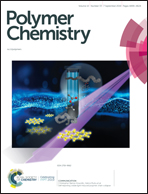Benzocyclobutene-functional double-decker silsesquioxane: self-assembled hybrid resin for high-performance dielectrics and LED encapsulants†
Abstract
The optoelectronic industry is focused on developing new electronic packaging materials to improve the performance of optoelectronic devices. In this paper, two novel benzocyclobutene-functional double-decker silsesquioxane macromonomers (2BCB-DDSQ and 4BCB-DDSQ) were synthesized via hydrolysis of phenyltrimethylsilane followed by hydrolytic condensation and platinum-catalyzed hydrosilylation. The resulting cured resins, thermally cured from viscous macromonomers by a solvent-free process, had high thermal stability and excellent optical and electrical properties compared with those features of a resin cured without DDSQ. Compared with the crosslinked porous microstructure of p-2BCB-DDSQ, we observed an orderly assembled structure, which was well dispersed in p-4BCB-DDSQ. We further used computer simulations to analyze these self-assembled hybrids, formed by π–π stacking and intramolecular/intermolecular crosslinking reactions. The unique microstructure of p-4BCB-DDSQ showed better performance compared to that of p-2BCB-DDSQ in terms of its low dielectric constant, low water uptake, high heat transfer rate, and high LED luminous efficiency. Hence, this material has potential applications in high-performance electronic packaging materials.



 Please wait while we load your content...
Please wait while we load your content...